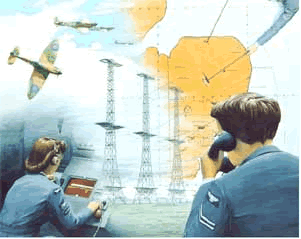In 1939 Germany invaded Poland
which marked the start of World War II. Less than a year later most of
Western Europe was under Nazi control. Hitler now turned his attention
to Great Britain. In order for an invasion to succeed, Hitler needed control
of the English Channel. Hitler's Navy was not up to the task so he relied
on the Luftwaffe which, up to now, had smashed all resistance. On paper
the Luftwaffe looked the superior force with 2,400 fighters and bombers
up against 900 British fighter planes. Facing such overwhelming odds the
British needed a way to eliminate the German element of surprise and target
the incoming forces.

Hope was restored with the development of the Chain Home radar system. This system was possible through the extraordinary work of a radio researcher named Sir Robert Watson-Watt. By 1940 the British had in place an entire network of long-range early warning radar stations that were tightly integrated by Fighter Command. This system could detect planes at a range of 150 km. Radar was an exceptional force multiplier as it allowed the British to concentrate their limited resources in areas where they were needed. British fighters were no longer needed to fly constant missions over the East Coast of England and less time was spent in the air patrolling the sky.

Painting of the Home Chain Command
German radar
operated in a narrow frequency range and was susceptible to jamming. Early
attempts to disrupt enemy radar came in the form of chaff. Chaff was made
from aluminium strips cut to exactly a quarter of the length of the radar's
wavelength. Chaff was first used in July 1943, when Hamburg was pounded
by a relentless bombing raid. The chaff reflected the German radar which
cluttered the screens of Air Defence. With German air defence completely
blinded, allied bombers were free to bombard the city without fear of
attack from enemy fighters.
As the war unfolded, higher and higher frequencies were been used. The
Chain Home radar system used frequencies of around 20 MHz during the war.
By the end of the war, invention of the magnetron enabled the American
H2S bombing radar to operate at 3GHz. Such a high frequency gave an excellent
resolution of the underlying terrain.,
By the end of the Battle of
Britain over 1,400 German Aircraft were destroyed with the loss of many
trained pilots as opposed to 900 British fighters with the loss of half
the British pilots.
Facing overwhelming odds, the RAF defeated the Luftwaffe in the Battle of Britain. Explain how radar assisted the British in defending London.
Had the Luftwaffe targeted airstrips during their early raids, rather than bombing London, would the result of the war have been different? Explain.
Explain how chaff enabled the jamming of German radar.
What is a magnetron?
How did the invention of the magnetron change aerial bombing?
Where is the magnetron commonly used now?